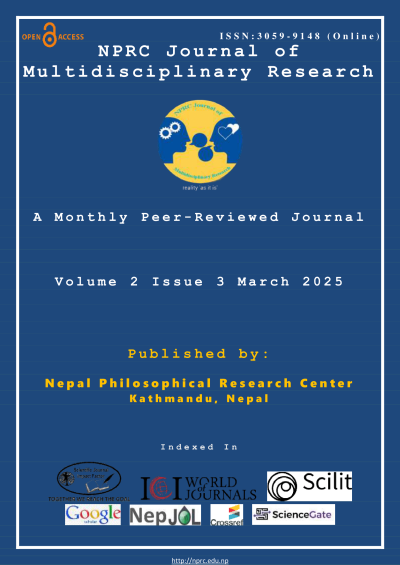Impact of Macroeconomic Indicators on Stock Market Performance: Evidence from Nepal
DOI:
https://doi.org/10.3126/nprcjmr.v2i3.77059Keywords:
Nepal Stock Exchange (NEPSE), Auto-regression Distributed Lagged (ARDL), Econometric Model, Macroeconomic VariablesAbstract
Background: The stock market is a critical indicator of economic activity, reflecting both investor sentiment and macroeconomic conditions. Understanding the relationship between stock market performance and macroeconomic variables is essential for policymakers, investors, and financial analysts. Objective: This study aims to analyze the relationship between the Nepal Stock Exchange (NEPSE) and key macroeconomic variables, including deposits, reserve money, liquidity, and lending interest rates, to determine their short-term and long-term effects on market performance. Methods: Using time-series data from 2005 to 2024, this study applies the Auto-Regressive Distributed Lag (ARDL) model to examine both short-term and long-term equilibrium relationships. The model assesses the impact of macroeconomic indicators on NEPSE while controlling for external economic shocks. Findings: The results indicate that NEPSE exhibits strong momentum, with past values significantly influencing current market trends. Lending interest rates have a significant negative impact, suggesting that higher borrowing costs discourage stock market investment. Liquidity and deposits do not have an immediate effect on NEPSE but show significant lagged effects, implying delayed investor responses. Reserve money initially reduces NEPSE due to inflationary concerns but later contributes to market recovery. The model's high R-squared value and significant F-statistic confirm its predictive strength. However, external shocks, political instability, and global economic fluctuations remain unmodeled. Conclusion: The study highlights the complex interactions between macroeconomic variables and stock market performance, emphasizing the role of monetary policy in shaping investor behavior. The findings provide valuable insights for policymakers in designing strategies to stabilize and promote stock market growth. Novelty: This study contributes to the literature by utilizing the ARDL model to capture both short-term and long-term dynamics in NEPSE, offering a comprehensive analysis of market behavior. It also suggests future research directions, including incorporating foreign exchange rates and investor psychology to improve predictive accuracy.
Downloads
Downloads
Published
How to Cite
Issue
Section
License
Copyright (c) 2025 The Author(s)

This work is licensed under a Creative Commons Attribution-NonCommercial 4.0 International License.
This license enables reusers to distribute, remix, adapt, and build upon the material in any medium or format for noncommercial purposes only, and only so long as attribution is given to the creator.





